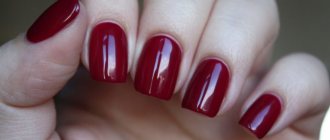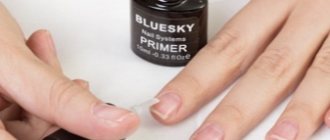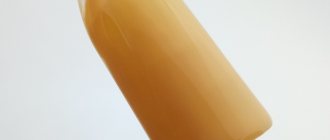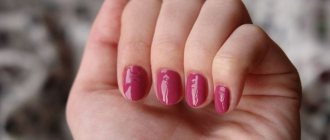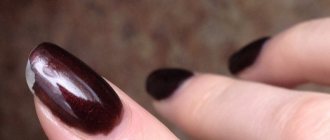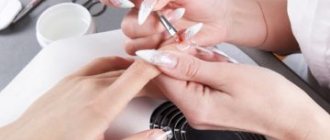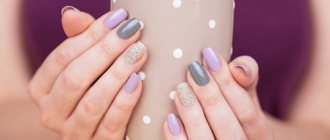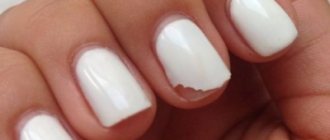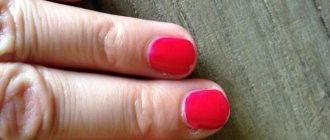Home page » Beauty » Nails
Author of the article
Svetlana Pavlikhina
Reading time: 6 minutes
AA
Manicure at home is always simple, painless, and safe. Using a minimal set of tools and varnishes that match the color, you can get your hands in order no worse than in a salon. There are many nuances that can ruin the result.
If the nail polish bubbles or layers unevenly, this is a consequence of improper application. Below are answers to the question of what to do for a perfect nail coating without bubbles and roughness.
Bubble Formation
Roughness forms during and after application if you vigorously shake the bottle with the product. This is done to thoroughly mix the liquid, even out its structure and color.
After intensive mixing, leave the varnish alone for 1-2 minutes, then begin the procedure.
Without proper preparation of the nail for painting, the coating may swell, so first the nails are degreased with a special liquid and polished with a fine-grained file. After such manipulations, the base fits perfectly on the nail.
If you wash your hands shortly before the procedure, moisture remains on the stratum corneum, and when applying layers, it does not allow the product to lie flat. It is necessary to dry your hands well shortly before applying the product .
The quality of the coating is also affected by the structure of the nail (unevenness, roughness, porosity).
The stratum corneum is deformed under the influence of the following factors:
- Hand and skin diseases (fungal diseases).
- Vitamin deficiency, deterioration of the skin and nail plate.
- Using aggressive detergents without gloves.
Under the influence of any chemical components, the nail becomes thinner, brittle and porous. The varnish coating is poorly applied and adheres to it, and bubbles appear after drying.
Bubbles due to improper manicure technique
Modern manicure is technological: nails are processed step by step in strict sequence. Then why do bubbles appear when applying gel polish ? Problems must be looked for in manicure technology.
Coating Errors
Before coating, the nail is sanded with a buffer, filed, then treated with a degreaser and dehydrates. The entire manicure depends on the pre-treatment of the surface.
- Poor preparation of the nail plate. If the nail is poorly polished, unevenness and bumps will form. Air gets in here, and the gel polish bubbles when applied . Areas with residual fat or moisture prevent uniform adhesion of the plate to the gel and swell over time.
- Soaking nails before manicure. As you know, the stratum corneum absorbs water well. If your nails have been in water for a long time, they will swell. Even a primer cannot completely correct the situation. Before a manicure, postpone washing, cleaning, hand baths, as well as showering and going to the pool.
- Thick layer of gel. To obtain a glossy surface and rich color, two layers of coating are sufficient. Many ladies are not sure about this, so they spend 3-4 applications. In this case, the lower layers do not have time to dry and begin to swell. This is why nail polish bubbles after application .
- The pressure with the brush and the direction of the strokes matter. Air bubbles are formed due to the loose fit of the bristles during application. The brush should be held almost parallel to the plate, strokes should be made with smooth movements from the base of the nail to its tip. There is no need to dip the brush brush into the solution too much. Excess will get on the skin and open the way for air.
- Shake the gel bottle before application. Such manipulations disrupt the uniform consistency of the product. As soon as the bottle is opened, air and moisture enter. As a result, the gel polish bubbles after drying , and you frantically think about what to do with it.
In fact, improper drying of gel nails itself can lead to the formation of air bubbles.
Reasons for the appearance of blisters after the coating dries
The formation of such deformation is influenced by 3 factors:
- layering the product multiple times;
- improper drying;
- use of oily nail and hand care products shortly before the procedure.
It is important to consider all these factors to create a neat manicure.
Reason 1: layering
If you layer the coating repeatedly, then after drying tubercles appear on the surface. It is not recommended to use more than 3 layers .
For the first application, use a base, then a color coating, then a fixer, glossy coating or top coat for gel varnishes.
If you apply more layers, their surface will become covered with bubbles, crack, or come off in layers the next day.
Reason 2: improper drying
You need to dry your nails under special lamps or in a calm state. Waving your arms is not recommended. When exposed to air, the varnish will form bubbles if the rules are not followed.
Reason 3: Using an oily hand product
This product and varnish products have a different structure. The cream always contains oils or fatty acids, petroleum jelly, glycerin, which are its basis. The reason for the appearance of roughness: these substances have poor contact with the varnish structure, covering the surface of the nail with a thin, greasy film, which does not allow the varnish to adhere to the upper stratum corneum, so irregularities appear.
Poor quality materials
The choice of components for manicure must be taken with great care. The consequences of bad materials are not only bubbles, but also allergic reactions.
- Damaged varnish. If the bottle is not closed after use or the cap is not screwed on properly, moisture and air will get in. Oxygen is a catalyst for chemical reactions, as a result the composition of the coating changes. Here you have peeling and chipping of the coating, the appearance of bubbles when applying gel polish during drying and after the procedure.
- Use of incompatible materials. This happens when treated with compounds from different companies. Each manufacturer offers its own development of primers, degreasers, and varnishes. There may be antagonist components that enter into chemical reactions to form droplets of liquid or gas. Here is your answer why nail polish bubbles after application .
- Materials of questionable quality. These are expired gels, “cheap” China, counterfeits of well-known brands. Expired gels dry out and change consistency, which leads to cracking and bubbling of the manicure. Well, no one dares to say what is included in fakes and cheap materials.
Whatever the reasons for the appearance of bubbles on the nails after applying varnish , you want to get rid of the defect as quickly as possible. Yes, so as to preserve the manicure.
Formation of tubercles after drying
Gel products and shellacs swell under the influence of a lamp when using a low-quality coating. Cheap dried products that are used many times deteriorate and bubble after drying.
If the manicure is done at home, the roughness is formed by dried particles of varnish. They form on the neck of the bottle after repeated use of the product.
Air appears when the liquid is vigorously shaken.
If drying was done with a hair dryer, blisters will certainly form on the surface. Intense waving of your arms while drying also provokes the formation of unevenness.
Washing hands and dishes immediately after the procedure contributes to the appearance of unevenness, because the varnish has not completely dried, all its layers have not “settled”, water can disrupt the structure and spoil the smooth coating.
They begin to do anything with their hands only after the product has completely dried: when pressed, the coating does not roll off, and no fingerprints remain on the surface.
Useful tips
But sometimes just performing a manicure correctly is not enough and bubbles appear on the nails, and the coating itself peels off and cracks. Therefore, you need to know some more subtleties, the observance of which will help get rid of the appearance of any defects and flaws on the nails.
Particular attention must be paid to the proper storage of nail polishes and bases for them. Such products should be kept in a fairly dark and at the same time cool place.
The optimal storage temperature is 18-20 degrees; at higher temperatures, the varnish begins to thicken greatly, and at low temperatures its texture is disrupted.
It is imperative to monitor the suitability of the products used; as soon as their possible service life expires, they should be disposed of. Expired varnish, as well as low-quality varnish, will never be able to provide a correct and beautiful coating; moreover, they negatively affect the structure of the nail and lead to its destruction.
Preference should be given to well-known manufacturers of nail polishes; they value their customers and take care of them, and therefore, in the production of their products, they try to use gentle technologies and do not use a large number of dangerous and harmful ingredients.
When performing a manicure at home, you should use products that were produced in one line of products and by one manufacturer. As a rule, it is these products that perfectly complement each other and provide high-quality coloring without any flaws. It is recommended to always use a nail polish fixer; it provides a denser coating and prevents premature peeling of the nail polish.
If you decide to get a manicure right after a bath or shower, be prepared for the fact that it will definitely come out with bubbles. The nails will be too wet and porous, so you won’t be able to paint them evenly. It is best to start a manicure directly a couple of hours after performing water procedures.
Therefore, they need to take a day off at least one day during the week: make special masks, baths and compresses. These cosmetic procedures allow you to strengthen your nails, get rid of tubercles on them and any imperfections, and therefore contribute to the correct and uniform application of varnish without defects.
Why do bubbles form?
Reasons for uneven application of nail polish:
- damaged dried varnish;
- hard or uneven brush;
- nail plate with deformation.
These factors affect the uniformity and gloss of the coating. To obtain an ideal surface, every point should be taken into account.
Varnish structure
When a product sits for a long time without being used or is poorly sealed, it dries out. A solvent may appear on the surface, the structure will delaminate, and such a coating may not lie evenly on the nail plate. It is not advisable to use it.
Brush
A thin brush with bent, stiff bristles or stuck pieces of dried polish may not cover your nails evenly.
If the contents of the bottle can still be used, then the brush should be replaced with a new, softer one, without adhering particles.
Nail
Bubbles form on an uneven, curved nail plate when applying the coating. To eliminate this defect, the nails should first be thoroughly treated with a soft file and degreased.
Afterwards, a thick consistency varnish is applied, which is used as a leveling agent. It is able to provide an even coating and prevent the formation of blisters.
Preparation for application
To avoid the formation of roughness when layering, the product should not be shaken before use. It is better to mix it and warm it up by rolling it between your palms. This way the coating will become uniform, elastic, and no blisters will appear.
How to avoid the problem
To make your manicure more durable, just follow these simple recommendations:
- Store varnishes in a dark, not hot place. Before use, warm it in your palms and warm it in warm water for a while. Remove dried fragments from the necks of the bottles.
- Monitor the expiration date of products. It is a spoiled product that can cause harm from gel nail polish.
- Use products from the same manufacturer for coverage.
- Apply in layers, pressing the brush firmly onto the nail. Give each new layer time to dry.
- Apply the coating to clean, prepared, dried and grease-free nails.
- Use a fixative.
Maybelline Color Sensation lipstick has a special attitude towards texture and color.
Step-by-step application of gel polish.
How to prevent bubbles
A manicure takes a lot of time and it is very disappointing if, after all the efforts, the coating does not look perfect. To prevent this from happening, certain rules must be followed. It is easier to apply the varnish evenly at the very beginning than to correct emerging defects later.
Rules for layering the product (painting):
- The surface of the stratum corneum is prepared for the procedure - degreased. Oil-free nail polish remover is suitable. Then wipe dry. It is necessary to polish and level the surface with a special file.
- Before layering the varnish, the bottle is heated in your hands by rolling it; shaking the contents is not recommended. Then you need to remove dry particles from the neck of the bottle with a cotton swab moistened with acetone. Do this carefully so that fibers do not get into the bottle.
- To make the structure of the varnish uniform, you can place the bottle in warm water for 2 minutes before use.
- The base, coating and top are chosen from the same brand or manufacturer: products of the same line have the same composition, and they will not “argue” with each other.
- After application, the colorless base is allowed to dry thoroughly, only then can the colored layer be applied.
- All coatings are applied in a thin layer, while the brush is pressed tightly to the nail - this avoids the formation of bubbles.
- Do not paint the cuticle or skin of the finger.
- The coating is completed with a clear varnish or sealer.
- Gels and shellacs are dried using a special lamp. A product for home use based on acetone is dried in a calm state, without waving your hands, without blowing with a hairdryer or immersing your hands in water.
- Preparations for quick drying (sprays, gels) are used if there is no time for the fresh coating to dry naturally.
It is important not to use products that have expired.
How and with what to get rid of bubbles of nail polish
If the manicure is unsuccessful, it is advisable to get a new one. When there is no time for this, it is possible to disguise defects. The first thing that comes to mind is stickers with pictures. They are sold with an adhesive base and easily stick to the base of the nail. Secure the sticker with a finishing coat and dry it in a lamp.
If there are a lot of bubbles and they are located throughout the nail, hide the imperfections with a colorless coating with glitter and heterogeneous particles.
If the coating has not had time to dry, apply a layer of composition on top that facilitates trouble-free drying of the manicure. It removes bubbles in 5 minutes. If there is a needle, the fresh composition on the nails is pierced with a needle. The point of this manipulation is to let the air out.
How to smooth out raised bumps
You can get rid of blisters and even out a fresh layer using topcoats designed for this purpose. They can dissolve the top uneven coating and fill it with their own structure.
When dry, the treated surface becomes absolutely smooth and even. This fixative is a quick and easy way to remove bubbles from nail polish.
Why does the gel polish base bubble?
When you apply the base, you are also 100% sure that the coating will not become bubbly later. Many fashionistas assign the base a secondary role in creating a manicure, which is wrong. The base is a “shield” of the nail from harmful substances; some bases even contain healing components to improve the nail plate.
The surest way to avoid “blowing” of the base is to use the base and color from the same manufacturer. Carefully monitor the drying process of each layer. Apply base to the nail only when you are sure that the nail is thoroughly dry from the degreaser. And the top layer, when the previous layers are well dried. Degreaser and alcohol dry out the nail plate; you can avoid their use by simply washing your hands with soap and drying them thoroughly. Not everyone knows, but there is an express product that dries nails. This is a great way to reduce manicure time and get rid of unwanted consequences.
Important to remember! Each gel has its own application characteristics, which must be taken into account when creating a manicure.
When you have purchased a varnish that you have not worked with before, you can try it out as an experiment. Then you will definitely be confident in its reliability, and the question of why the gel polish bubbles (swells) will not arise. After spending a little time experimenting, you will get a great manicure.
If you neglected some of the rules described above, and bubbles still appear on the coating, you can disguise them with stickers so as not to completely redo the manicure. The nails will have an interesting design that will save them for a while. However, such a “wavy” coating will not last long.
Cheap coatings can also give unnecessary effect to your nails. Therefore, it is better to buy one good gel than several cheap ones, which are no good and lead to brittle nails. Never rinse the brush with water or apply coating after a bath.
Follow the rules for applying the coating, read the instructions for the gels, adhere to the technology, and only then will you get an irresistible manicure.
